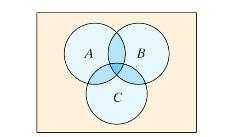(P(A)=0.38, P(B)=0.26, P(C)=0.14), (P(A) and (B)=0.12, P(A) and (C)=0.03, P(B) and (C)=0.09), (P(A) and (B) and (C)=0.01)...
Question:
\(P(A)=0.38, P(B)=0.26, P(C)=0.14\), \(P(A\) and \(B)=0.12, P(A\) and \(C)=0.03, P(B\) and \(C)=0.09\), \(P(A\) and \(B\) and \(C)=0.01\)
The Addition Rule for the probability that event \(A\) or \(B\) or \(C\) will occur, \(P(A\) or \(B\) or \(C)\), is given by \[ \begin{aligned} P(A \text { or } B \text { or } C)=P(A) & +P(B)+P(C)-P(A \text { and } B)-P(A \text { and } C) \\ & -P(B \text { and } C)+P(A \text { and } B \text { and } C) \end{aligned} \] In the Venn diagram shown at the left, \(P(A\) or \(B\) or \(C)\) is represented by the blue areas. In Exercises 27 and 28, find \(P(A\) or \(B\) or \(C)\).
In the Venn diagram shown at the left, \(P(A\) or \(B\) or \(C)\) is represented by the blue areas. In Exercises 27 and 28, find \(P(A\) or \(B\) or \(C)\).
Fantastic news! We've Found the answer you've been seeking!
Step by Step Answer:
Related Book For 

Question Posted:





